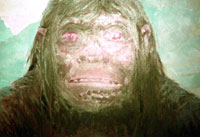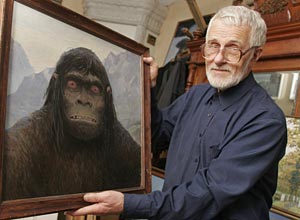May 14, 2007
Mecheny, a Marked Hominid, as drawn by artist Harry Trumbore in The Field Guide to Bigfoot and Other Mystery Primates.
Victoria Alexander, in the midst of a blog about several non-cryptozoological items, records the following interesting passage:
Wildman of Russia. I finally came across Valentin Sapunov’s report I received when in Russia in 1992. I’d been looking for it for years! Sapunov told me and my colleagues Dr. Rima Laibow and General Bert Stubblebine that in 1989 there was an appearance of a giant white haired man near a military base 50 km from Leningrad. Sapunov interviewed the witnesses.
Soldiers began to detect a tall white figure near the gate of the military compound. It looked like a man and a giant ape.
The strange visitor was seen near the barracks, dining room and library. They named the visitor “Big White Man.” Hundreds of civilians, including policemen, also saw the “Big White Man.”
The Wildman became more cautious when under surveillance, but several of the soldiers reported making prolong contact with the creature. Sapunov and his team collected many specimens indicating that there were two creatures: one male and one female.
(The photo [directly below] taken by me comes from a Russian exhibition of paintings of Wildman done by an artist who encountered the creature.)Victoria Alexander, Devil’s Hammer, May 14, 2007

A better photo of one of these paintings (below) was shown in my earlier blog on these Wildpeople. Please click on “Russian Relics” to read more and also see possible footprints of these unknown hominoids.

Intriguingly, palebald Wildpeople, with two-tone, multi-colored hair patterns, as well as near-albino and patches of lighter hair, are frequently sighted in Russia and Siberia. The illustration at top, by Harry Trumbore, from The Field Guide to Bigfoot and Other Mystery Primates (NY: Anomalist Books, 2006: pp. 114-115) is of Mecheny (translation, “the Marked One”).
Mecheny showed a white patch on its arm. It was seen for over 40 years (1945-1987) near a native family’s western Siberian cabin. The hominologist-cryptozoologist Maya Bykova visited the cabin in 1987, and saw the hairy hominoid near the forest’s edge, about 15 feet away, on two separate occasions, once for an hour.
The lines between the “Big White Man,” Mecheny (the “Marked One”), and “Old Yellow Top” (of Cobalt, Ontario; pages 48-49) do tend to merge.
It is time to relook at Homo gardarensis, as Mark A. Hall suggests in a new call on his website this week.
About Loren Coleman
Loren Coleman is one of the world’s leading cryptozoologists, some say “the” leading living cryptozoologist. Certainly, he is acknowledged as the current living American researcher and writer who has most popularized cryptozoology in the late 20th and early 21st centuries.
Starting his fieldwork and investigations in 1960, after traveling and trekking extensively in pursuit of cryptozoological mysteries, Coleman began writing to share his experiences in 1969. An honorary member of Ivan T. Sanderson’s Society for the Investigation of the Unexplained in the 1970s, Coleman has been bestowed with similar honorary memberships of the North Idaho College Cryptozoology Club in 1983, and in subsequent years, that of the British Columbia Scientific Cryptozoology Club, CryptoSafari International, and other international organizations. He was also a Life Member and Benefactor of the International Society of Cryptozoology (now-defunct).
Loren Coleman’s daily blog, as a member of the Cryptomundo Team, served as an ongoing avenue of communication for the ever-growing body of cryptozoo news from 2005 through 2013. He returned as an infrequent contributor beginning Halloween week of 2015.
Coleman is the founder in 2003, and current director of the International Cryptozoology Museum in Portland, Maine.
Filed under Abominable Snowman, Almas, Artifacts, Bigfoot, Books, Breaking News, Cryptomundo Exclusive, Cryptotourism, CryptoZoo News, Cryptozoologists, Cryptozoology, Expedition Reports, Eyewitness Accounts, Folklore, Yeti